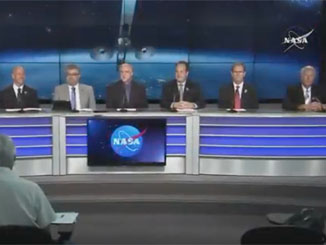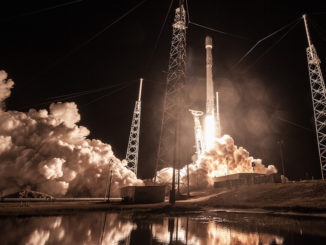
The U.S. military’s experimental spaceplane will soon soar to orbit using a SpaceX Falcon Heavy rocket for the first time, a Pentagon news release announced. The X-37B spacecraft will launch from NASA’s Kennedy Space Center no earlier than December 7.
The Falcon Heavy launch will mark the seventh flight of the X-37B Orbital Test Vehicle. The mini-shuttle is operated by Department of the Air Force Rapid Capabilities Office, in partnership with the United States Space Force. The mission was previously dubbed USSF-52 by the U.S. Space Force.
“We are excited to expand the envelope of the reusable X-37B’s capabilities, using the flight-proven service module and Falcon Heavy rocket to fly multiple cutting-edge experiments for the Department of the Air Force and its partners,” said Lt. Col. Joseph Fritschen, the X-37B Program Director, in a statement.
The news release said the mission would see the spaceplane operate in “new orbital regimes” without any specific details. Previous X-37B missions have operated in low Earth orbit.
The spaceplane is designed for long-duration missions on orbit for various tests and experiments on behalf of the Space Force as well as NASA. This upcoming flight, OTV-7, will include a radiation experiment called “Seeds-2,” which will study the impacts of radiation on various plant seeds during long-duration spaceflight.
The upcoming flight will also be “experimenting with future space domain awareness technologies” in order to ensure “safe, stable, and secure operations in space for all users of the domain.”
OTV-7 will mark the first launch of the X-37B on a Falcon Heavy rocket. The fifth flight of the spaceplane took off on a Falcon 9 Block 4 rocket back on Sept. 7, 2017. The other four launches used a ULA Atlas 5 rocket to get to orbit.
Continuing a legacy
While the length of this upcoming flight has not been disclosed, each previous mission of the X-37B got progressively longer. The most recent flight launched back on May 17, 2020, and landed on Nov. 12, 2022 at Space Florida’s Launch and Landing Facility at KSC.
That mission was the first to include a service module, which attached to the rear of the spaceplane, allowing for more experiments to fly onboard. It too included a seeds experiment for NASA as well as the FalconSat-8, a satellite built and operated by U.S. Air Force Academy cadets, which remains in orbit.
There are two spaceplanes currently in the X-37B program, thought it was not disclosed which one will be launching on this upcoming mission.
This mission also continues the relationship between USSF and SpaceX to further validate its launch capabilities.
The Falcon Heavy side boosters that will launch on this mission, B1064 and B1065, will make their fifth flight. They were first used on USSF-44, which launched on Nov. 1, 2022, and have subsequently flown on USSF-67, Jupiter-3/EchoStar-24 and NASA’s Psyche missions.
The launch contract with SpaceX for this mission is valued at $154,726,072, according the U.S. Space Systems Command.
SpaceX and NASA said they plan to use these side boosters one last time in October 2024 to support the Europa Clipper mission to send a spacecraft to study one of Jupiter’s moons. That launch will take the full power of the Falcon Heavy and so, the side boosters and the core stage will all be expended.




